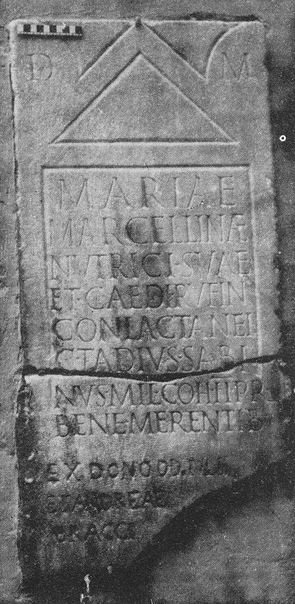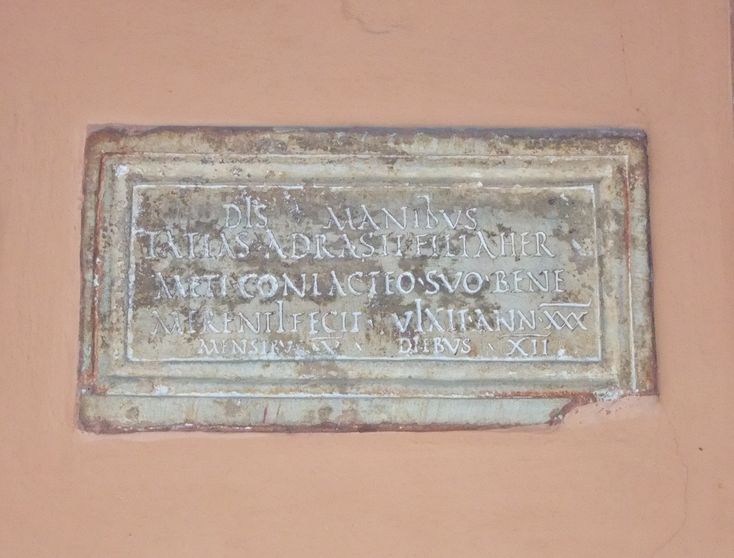One of my favourite things about the Roman death course I’m teaching this year is that every week teaches me something I never knew before. A few weeks ago, while I was translating some epitaphs to use in a lecture, a particular word caught my eye.
The inscription ran:
Rottio hic sit[us es]t iuve/nili robore quondam / [q]ui sibi moxq(ue) su[ae] nutrici / Marcian(a)e item Verinae / conlactiae haec monu/menta dedit et sub asc(ia) / dedicavit / curante Cl(audio) Sequente patrono (CIL 13 2104 [part])
Here lies Rottio, once with youthful strength, who gave these monuments for himself and soon for his nurse Marciana and also Verina his conlactia and dedicated them under the trowel, with Claudius Sequens his patron taking care of them.
This word conlactia really caught my eye. It’s not in any of the main Latin dictionaries, as far as I can tell, but it’s pretty clear what it means – someone you drink milk with, that is, someone nursed from the same breast or, as I said to the students (only partly joking), “milk-buddies”.
Unrelated children could quite commonly end up nursed by the same woman in ancient society because of the use of wet-nurses. If a mother could not, or did not want to, nurse her own child, then the family would hire a wet-nurse. In some cases, this would be a woman who was still producing milk after her baby had died; in other cases, it would be a woman whose baby was alive, but who had a surplus of milk. The wet-nurse would feed and look after both babies, her own and her employer’s, at the same time.
A little investigation shows that the inscription I found is far from unique. There are at least several dozen inscriptions surviving which commemorate the relationship between two children nursed together (as far as I can determine using the Epigraphik Datenbank), with slight variations in the word used. In some cases it is clear that their close relationship lasted well into adulthood:

Dis Manibus / Tatias Adrasti filia Her/meti conlacteo suo bene / merenti fecit vixit ann(is) XXX / mensibus V diebus XII (CIL 6 27119, Rome)
To the spirits of the dead, Tatias daughter of Adrastus made (this) for her conlacteus Hermes, well-deserving. He lived 30 years, 5 months, 12 days.

D(is) M(anibus) / Mariae / Marcellinae / nutrici(s) suae / et Caedi Rufini / conlactanei / C(aius) Tadius Sabi/nus mil(es) coh(ortis) II pr(aetoriae) / bene merentib(us) (CIL 11 6345)
To the spirits of the dead of Maria Marcellina, his nurse, and Caedus Rufinus, his conlactaneus, C. Tadius Sabinus soldier of the second praetorian cohort (made this) for them, well-deserving.
The formation of the word also stood out to me. It is similar in both formation and semantics to companio ‘mess-mate, companion’, which uses the idea of eating bread (panis) with someone as a representation of a particular kind of intimate relationship. But this is not a Classical Latin term – it first appears in the Frankish Lex Salica of around 500 AD, and appears to be a calque of a Frankish word formed of the same elements (with + bread). Interesting, then, that there was an existing Latin term using with + milk (plus a different nominalising suffix) to denote a non-familial close relationship. Did conlacteus affect the formation of companio? Probably not, if companio is a calque from a Germanic word, but I may have to give it a little more thought (any suggestions welcome).
In the mean time, I’m very glad I stumbled across this lovely memorial of an unusual relationship.
Images and texts from the Epigraphik Datenbank. Translations mine.


The wet nurse isn’t necessarily paid. I know of a family in Kazakstan where a woman nursed the child of a cousin, while nursing her own. The adult kids refer to each other as what would be translated as ‘milk sisters’.
LikeLike
Very interesting post, because you make us know a not wellmknown aspect of the Roman world.
LikeLike
Thanks Erik – I have read these, in fact, and (as far as I remember) neither discusses the “conlacteus” relationship really, which was my focus here, though of course she does discuss other aspects of wet nursing practices.
LikeLiked by 1 person
maybe you should check Anna Sparreboom’s https://www.academia.edu/6196503/Wet-nursing_in_the_Roman_Empire._Indifference_Efficiency_and_Affection including epigraphic catalogue, if you haven’t and her article in Carroll, M. and E.-J. Graham, Eds. (2014). Infant health and death in Roman Italy and beyond. Journal of Roman Archaeology. Supplementary Series, 96. ?
LikeLike
Thanks for the correction regarding “ascia” – I’ve change it in the translation above. (I thought it was a bit weird in the first place, but I seem to recall the XII Tables saying something about smoothing pyres with axes, so I left it.) Thanks!
Absolutely agree that “conlactia” = “conlacteus” with raising – interesting that there was also the -aneus suffix too.
“Foster-brother” is an interesting translation, I think. I guess that’s the closest equivalent in English, but I think it’s too general here. The fact that “conlacteus” so often appears with “nutrix” says, to me, that this is likely to be a relationship to do with nursing specifically, rather than generally being brought up with someone. But I guess the second example I’ve given could be a slightly different relationship, as no nurse is explicitly mentioned.
And thanks for “contubernalis” too! Intriguing that all of these examples use different nominalising suffixes though?
LikeLike
Interesting!
I think your ‘axe’ in the first IS may be a trowel. The Perseus version of L & S says: ‘A mason’s trowel … upon monuments such a trowel is found pictured, and in the inscription the expression SVB ASCIA or AD ASCIAM DEDICATVM, i. e. consecrated while yet under the trowel (prob this was done in order to protect the empty sepulchre from injury)’.
I suspect that conlactia may be the same word as conlacteus, with ‘vulgar’ raising of e > i in hiatus. L & S has collacteus as ‘foster-brother’, with references to ISS and – interestingly, given the much later companio – Juvenal 6, 307, and collactaneus ‘a brother or sister nourished at the same breast, a foster-brother or sister (post-calssical)’.
Of course, there is also contubernalis ‘the one you share a tent with’, also with an army context. So perhaps the use of companio, while ultimately a calque on something Germanic, already had the existence of similar formations already in Latin to help it be born.
LikeLike
Let’s recall Little Buttercup in “HMS Pinafore”:
A many years ago,
When I was young and charming,
As some of you may know,
I practised baby-farming.
……
Two tender babes I nussed [nursed]:
One was of low condition,
The other, upper crust,
A regular patrician.
……
Oh, bitter is my cup!
However could I do it?
I mixed those children up,
And not a creature knew it!
LikeLike
I don’t know too much about wet nurses in the ancient world generally, so I asked a couple of experts (@lizgloyn and @ltotelin). They said there aren’t any attested stories of this happening, so we really don’t know – it’s perfectly possible, it’s just not the kind of practice that would be recorded in our sources.
It would also be likely more economical just to use a nurse who had an over-supply of milk – wet nurses are often slaves in the ancient world, so the master would end up paying for the replacement milk for the other baby anyway. It would likely be easier to use a wet nurse whose baby had died (or perhaps been sold), or to use a nurse who produced enough milk for two.
LikeLike
Very interesting post. Just a question – wouldn’t wet nurses also deprive her own children of milk so they could get paid as wet nurses? I know my greatgrandmother nursed her employer’s baby and gave her own baby goat milk, surely that was a thing in ancient Rome too?
LikeLike